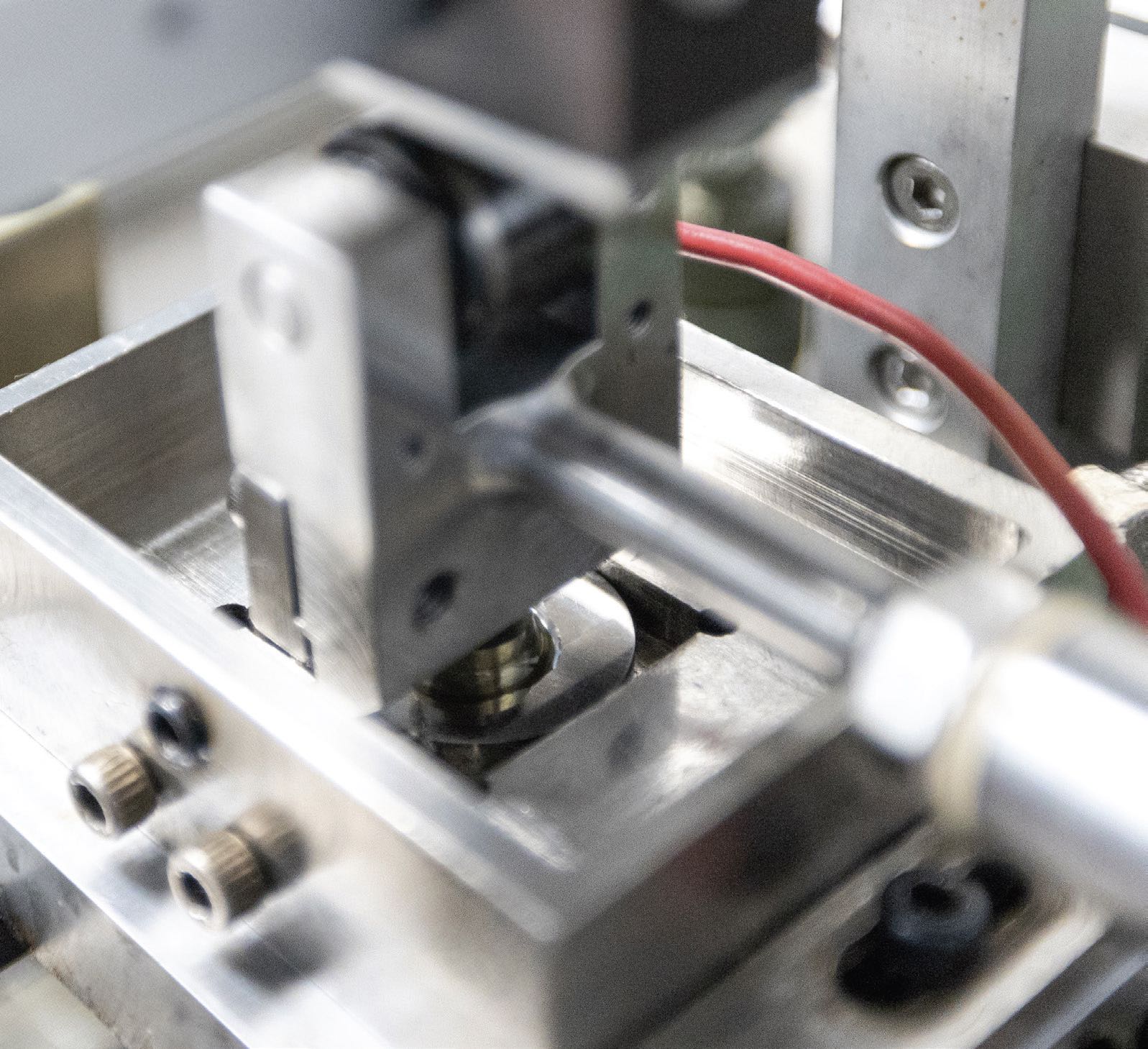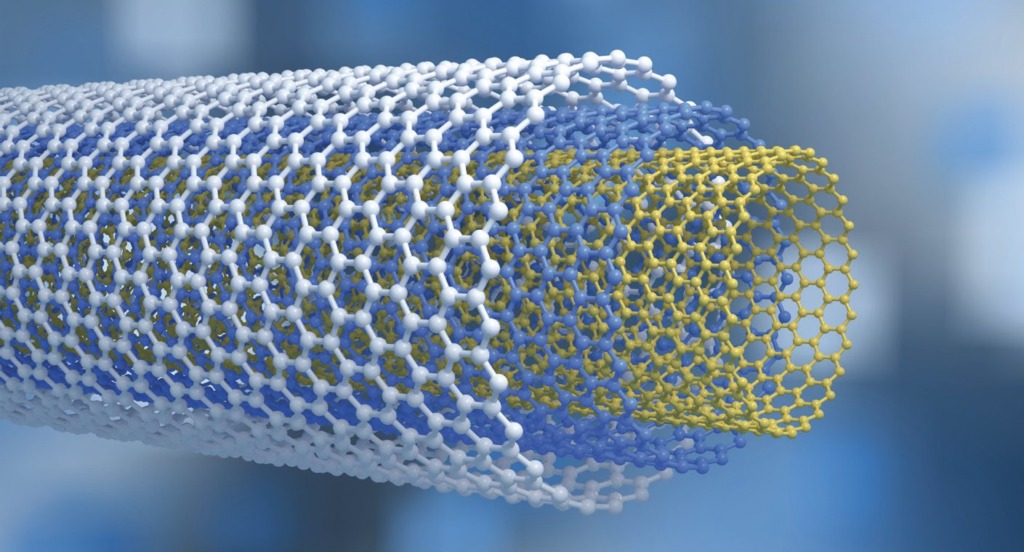Administration of the project
Superlubricity in a common bearing system
By Dr. Neil Canter, Contributing Editor | TLT Tech Beat October 2023
Disk-on-flat reciprocating sliding tests were conducted with a carbon nanotube-coated stainless steel disk under MQL conditions.
• Superlubricity has now been demonstrated on a CNT-coated stainless steel disk under macroscale steel-steel sliding conditions in an ambient environment.
• Coefficient of friction values declined into the superlubricity range after 5-50 cycles of the experiment and remained in that regime throughout initial testing over 5,000 cycles.
• The proposed mechanism suggests that the CNT coating is sacrificed in situ to form a tribofilm that creates the conditions for superlubricity.Improving the efficiency of machinery remains a longstanding goal of tribology researchers. Achieving superlubricity, or nearly frictionless sliding, which occurs when the coefficient of friction is less than 0.01, represents an approach for meeting this goal.
Two past TLT articles discuss work conducted on superlubricity. In 2015,1 researchers first saw superlubricity at the macroscale experimentally. The experiment involved a graphene-coated surface sliding against a diamond-like carbon (DLC)-coated surface under dry conditions. This interaction triggered the formation of graphene nanoscrolls that were stabilized through introduction of nanodiamond particles.
Using a ball-on-disk tribometer operating under a nitrogen atmosphere, superlubricity was observed when a ball coated with hydrogenated DLC was slid against a surface containing two-dimensional molybdenum disulfide and nanodiamonds.2 Coefficient of friction values in the 0.005 range were achieved due to a stress-induced chemical reaction that converted nanodiamonds into onion-like carbon structures.
STLE Fellow Dr. Jun Qu, group leader of surface engineering and tribology, distinguished R&D staff at Oak Ridge National Laboratory in Oak Ridge, Tenn., says, “Superlubricity is often only observed under very limited conditions that require ultrahigh vacuum or inert environments. In more recent cases, under ambient environments, water-based lubricants were used on very smooth ceramic surfaces to produce superlubricity under high-speed sliding conditions.”
While there is direct evidence of superlubricity, Qu believes that determining an approach that can be used with existing hydrocarbon lubricants will facilitate new opportunities for improving current machinery. He says, “In common applications, such as bearings, the solid surfaces often are steels, and lubricants are based on mineral oil or some other type of hydrocarbon.”
One option is to use carbon nanotubes (CNTs) under hydrocarbon lubrication to produce superlubricity. CNTs are cylindrical tubes made of sp2 hybridized carbon atoms bonded into a network of hexagonal lattice structures similar to graphene. Depending upon the number of graphene sheets inside, CNTs may be identified as single, double or multi-wall.
One of Qu’s colleagues, STLE member Dr. Chanaka Kumara, developed a procedure for synthesizing CNTs through a chemical vapor deposition (CVD) process on stainless steels and tool steels. Kumara says, “Initially, the steel surface is oxidized at elevated temperature to produce metal oxide nanoparticles on its surface. Then introduction of a carbon source, ethanol, under a reduced atmosphere at elevated temperature, led to the formation of a black color, CNT-coated, steel surface.” Both tool steel and stainless steel alloys are commonly used in bearings.
Qu and Kumara have now demonstrated superlubricity on a CNT-coated stainless steel disk under macroscale steel-steel sliding conditions in an ambient environment.
Sacrificial coating
The researchers conducted disk-on-flat reciprocating sliding tests (see Figure 1) with a CNT-coated Type 316 stainless steel disk, and an uncoated M2 tool steel flat at 0.5 Hz oscillation with a stroke of 10 millimeters. One drop of 4 cSt polyalphaolefin (PAO) was applied to the interface, basically a minimum quantity lubrication (MQL) condition.

Figure 1. The tribometer shown was used to conduct disk-on-flat reciprocating sliding tests to achieve superlubricity, or nearly friction-less sliding, under ambient conditions. Figure courtesy of Oak Ridge National Laboratory.
Qu says, “For the first 5-150 cycles of the experiment, coefficient of friction values remained in the 0.05-0.1 range, which is typical of a boundary lubrication regime. Further cycling led to a rapid reduction in the coefficient of friction into the superlubricity range (0.0001-0.007). Of significance is superlubricity was maintained throughout initial testing over 5,000 cycles, which represents 100 meters of sliding that took 2.8 hours to complete.”
Longer running tests demonstrated that durability of superlubricity. Qu says, “The reciprocating sliding tests were run for over 12 days (525,000 cycles) with no increase in the coefficient of friction. Additional droplets of PAO were added every three days to compensate for evaporation. At the time of addition, the test was stopped and then resumed. A friction spike was then observed, but then the coefficient of friction declined to below 0.01.”
While it is tempting to hypothesize that the mechanism for generating superlubricity might involve CNT segments as mini-rollers at the contact interface, there is no direct evidence for this phenomenon. On the other hand, the multi-wall CNTs are composed of rolled-up sheets of graphene. Qu says, “During the run-in phase of the tribotest, the CNTs fracture into small graphene flakes. Continuing thermomechanical stresses facilitate oxidation and mixing of the graphene flakes with metallic wear debris from the steel surfaces to deposit a graphene-rich tribofilm on both the contact surfaces, leading to an easy-to-shear interface.”
This mechanism suggests that the CNT coating is sacrificed in situ to form a tribofilm that creates the conditions in the reciprocating sliding tests for superlubricity. Scanning transmission electron microscopy and elemental mapping conducted using energy-dispersive X-ray spectroscopy data support this hypothesis by finding a mixture of carbon and metallic nanoparticles (primarily iron and chromium) in the tribofilm.
PAO, although merely one droplet, performs an important role to ensure that superlubricity is realized. Qu explains, “The oil prevents scuffing failure during the running-in phase, reduces adhesion between the two contact surfaces, minimizes the wear rate, removes wear debris from the interface and helps to align the graphene flakes in the tribofilm to being presumably parallel to the metal surface. In experiments run dry without oil, we noticed immediate scuffing and the coefficient of friction values were two orders of magnitude above the superlubricity level.”
The researchers intend to get a better understanding of the mechanism. Qu says, “We have seen that raising the temperature above 50 C leads to an increase in the coefficient of friction above superlubricity. Understanding this phenomenon will hopefully broaden the practical applications.”
Qu’s team also intends to evaluate other lubricants besides PAO to determine their effects. Candidates include mineral oils, polyalkylene glycols (PAGs) and esters. Additional information can be found in a recent reference3 or by contacting Qu at [email protected].
REFERENCES
1. Canter, N. (2015), “Superlubricity: Seen at the macroscale for the first time,” TLT, 71 (10), pp. 10-11. Available here.
2. Canter, N. (2018), “Generation of long-lasting superlubricity at the macroscale,” TLT, 74 (8), pp. 12-13. Available here.
3. Kumara, C., Lance, M. and Qu, J. (2023), “Macroscale superlubricity by a sacrificial carbon nanotube coating,” Materials Today Nano, 21, 100297.
Neil Canter heads his own consulting company, Chemical Solutions, in Willow Grove, Pa. Ideas for Tech Beat can be submitted to him at [email protected].
Original article in TLT magazine: https://www.stle.org/files/TLTArchives/2023/10_October/Tech_Beat_I.aspx.



Be the first to comment